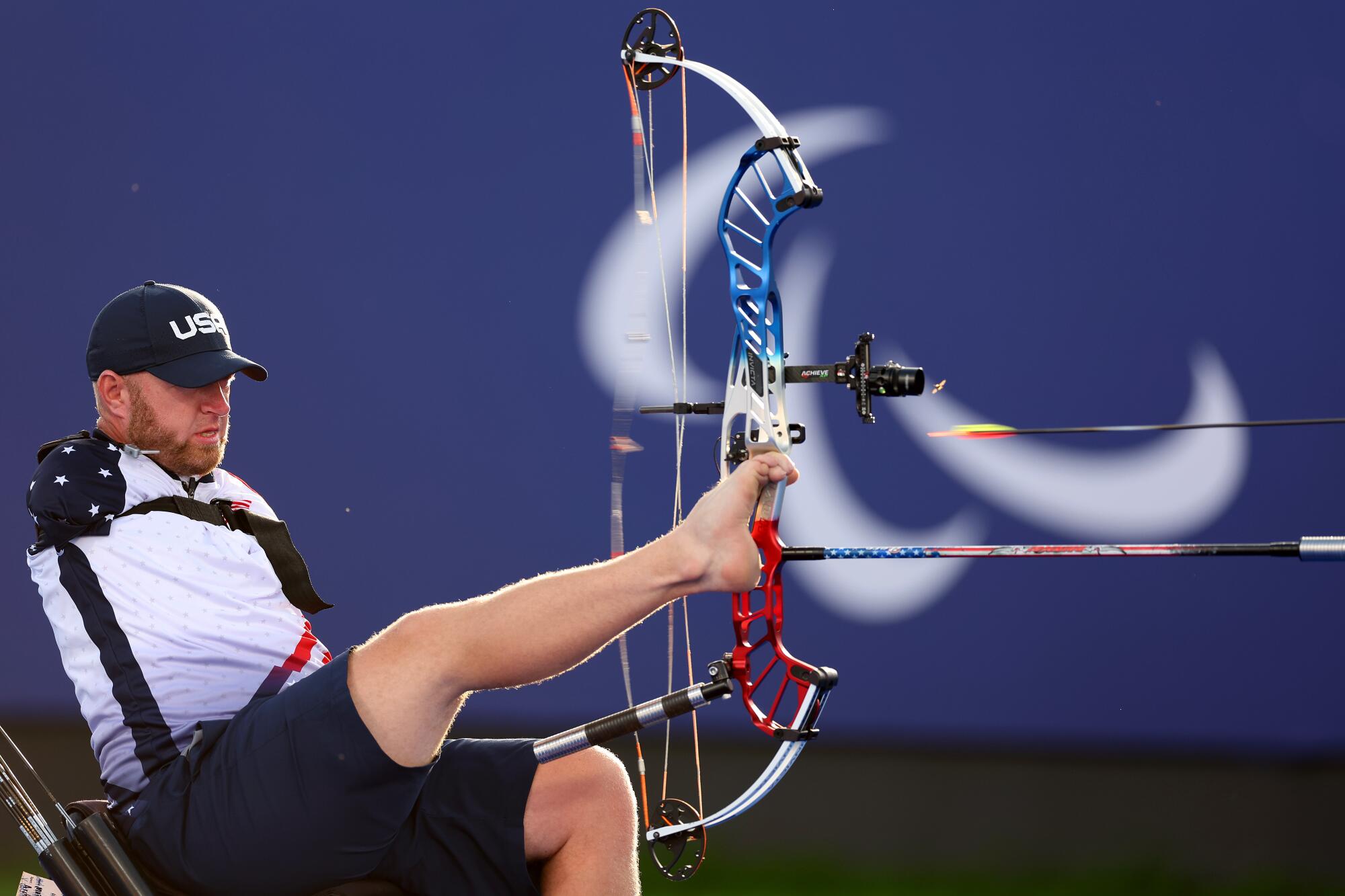
- Share via
No one would hire him. Not one store or business in his small Iowa town would take a chance on a young man born without arms.
“My wife was the one doing all the work and I felt like I wasn’t doing my part,” he recalls. “I felt bad.”
So Matt Stutzman bought a bow and some arrows. This made sense to him if only because he had grown up on a farm, tagging along with his dad and brothers on hunting trips. It seemed like a way to put food on the table.
“I really had no idea how I was going to shoot,” he says. “I googled ‘How to teach an armless man to shoot a bow’ and found nothing.”

Fueled by equal parts optimism and determination, Stutzman embarked on a quest that would make him a legend in the sport of para archery. His innovative technique for shooting, using only his feet, translated into top rankings and a slew of medals at tournaments worldwide.
Last week, the 41-year-old arrived in Paris for what he announced would be his last Paralympics. He called them “a ‘memories’ Games … making memories and just, like, having fun.”
As competition began on the manicured grounds at Esplanade des Invalides, this relaxed attitude worked to his advantage. Feeling loose, feeling good, Stutzman began to wonder: Could he finish his storied career with something no armless archer had achieved — Paralympic gold?
For those who never have seen Stutzman with a compound bow, never seen him hit the target dead-center from a Paralympic distance of 164 feet, here is a brief explanation.
Built sturdy, with a shaved head and a scruff of beard, he sits in a chair with his left foot planted on the ground. Loading the arrow with the toes of his right foot, he leans forward to latch the bowstring with a hook attached to his right shoulder.
Now comes the tough part. Clutching the bow in those strong toes, he raises it to chest level and straightens his leg to attain a full draw. A subtle shift of his jaw pushes a trigger to release the shot.

If all this seems amazing to a layman, it is equally implausible to people in the sport because no one ever did it before. Para archers in Stutzman’s classification traditionally have lower-body disabilities or impairment in one or both arms.
An International Paralympic Committee executive calls Stutzman “an absolute pioneer.” Chinese rival He Zihao says: “Matt is not just a para archer. He’s also the legend and the G.O.A.T. in the whole para sport.”
The archery world was eager to show its appreciation during what amounted to a farewell tour in Paris. People knew an aching right hip had forced Stutzman to curtail his training schedule and retirement seemed imminent after he finished the preliminary round in 19th place.
Not everyone could see he was quietly gaining momentum.
Back in 1982, doctors could not explain why the child was born armless. They did say, however, that raising him would be costly, with visits to specialists, physical therapy and modifications at home. His birth parents made the difficult choice to give him up.
The Stutzman family had no such concerns adopting him into their family of seven other kids. Not that they had tons of money; they simply viewed his disability from a different angle. As Stutzman says: “They were the type of parents who wanted to adapt me to the world instead of adapting the world to me.”
That meant teaching him to eat, comb his hair and brush his teeth with his feet. His mother refused to tie his shoes until he tried to do it himself at least one or two times.
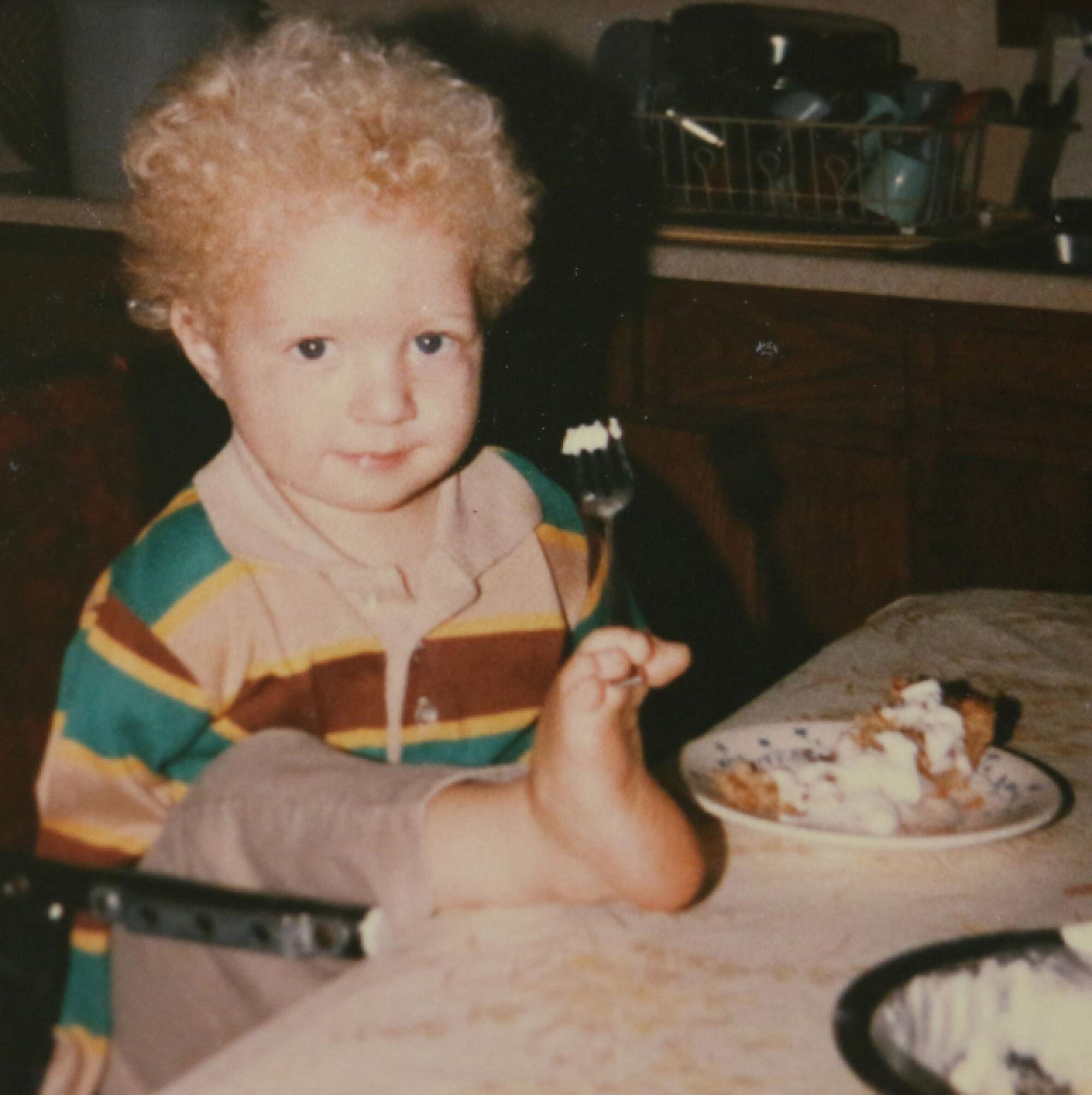
Learning to spread his toes wide, Stutzman developed a firm grip. When he and his brothers had “apple wars,” he could grab an apple and fire right back. By 8, he was driving a tractor around the farm, using one foot to work the pedals and the other to steer.
At 16, Stutzman went to the department of motor vehicles, excited to get his license, but was refused a driving test. He calls the episode “heartbreaking.”
For the next two years, he worked on his flexibility and proved to occupational therapists he could steer and brake as quickly as anyone. Returning to the DMV at 18, he demanded a chance.
And when he passed the test, he says, “I did a big donut in the parking lot.”
Through all of this, his reliably sunny disposition served as an elixir, helping him through times of despair. A steady smile and big laugh became his trademarks.
“He is always a positive person,” his fiancee, Jessica Wasson, says. “No matter where he’s at, he is always trying to make sure everybody feels included and is having a good time.”
About two months before Paris, Stutzman stopped shooting to give his hip a rest. He focused instead on mental preparation, which might explain his confidence after the lackluster preliminaries.
“Everything that I trained for just started flowing,” he says.
The head-to-head elimination matches have competitors shooting three arrows in each of five “ends,” with the bull’s-eye equaling 10 points, the outer rings successively less.
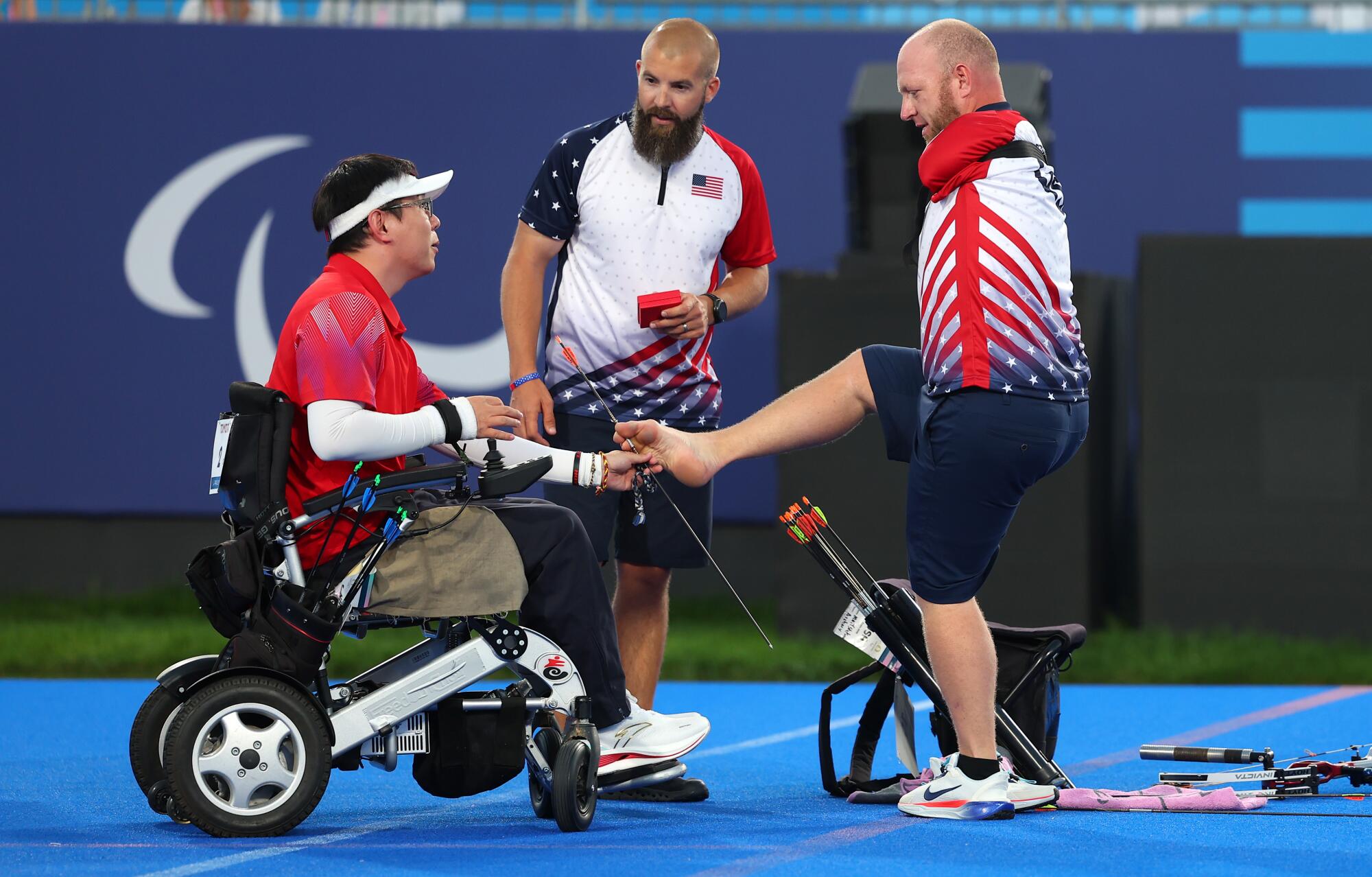
Stutzman started against Victor Sardina Viveros of Mexico, one of several armless archers who followed him into the sport and call him a mentor. Their match marked the first time two such archers faced each other at the Paralympics.
“He is very open and he shares his experience with us,” Sardina Viveros says, “so I’m very grateful to him.”
Cruising to a 142-136 win, Stutzman advanced to a tougher challenge against veteran Jere Forsberg of Finland. With the score tied after five ends, each took one more shot.
Both men hit the bull’s-eye, but Stutzman’s arrow was better, almost exactly dead-center, nudging him a step closer to the gold-medal match.
Learning to shoot required ingenuity. With no coaching, no videos online, Stutzman had to work it out in his head.
The shoulder harness with the hook was his invention. So was the technique that evolved through trial and error. After that first winter in 2009, when he shot two deer and put about 150 pounds of meat in the freezer, a buddy invited him to an archery tournament.
“So I walked in and took off my shoe to sign the waiver and asked the lady behind the counter, ‘Where are all the other armless archers?’ ” he recalls. “I literally thought I was going to compete against other armless people.”
Finishing near the bottom wasn’t fun. Even when an archery manufacturer called a few days later, offering free equipment, Stutzman suspected it was only because of the whole armless thing. Determined to be more than a novelty, he began practicing eight hours a day.
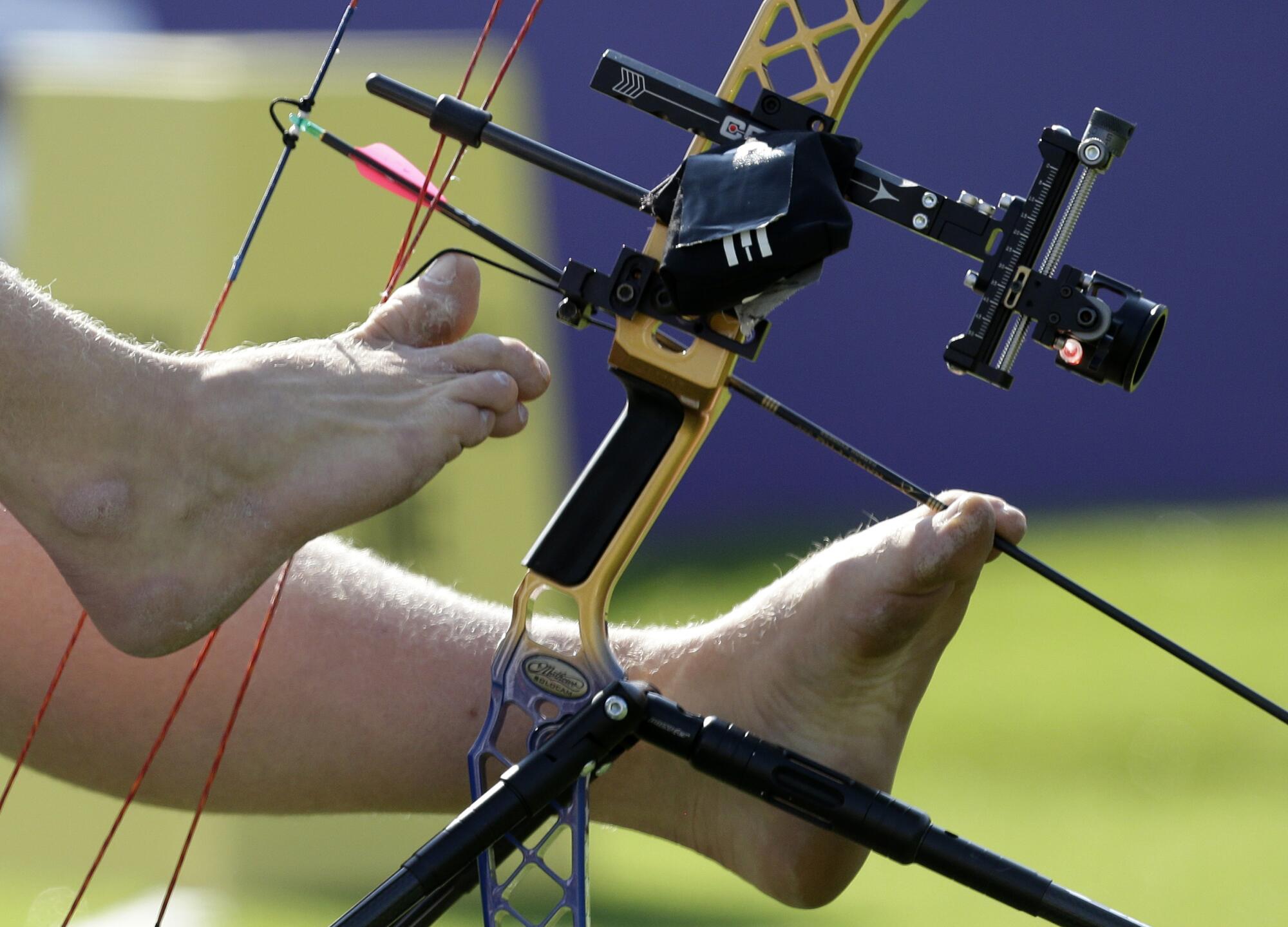
“I’d sit in my backyard,” he says. “I put a target out there and prayed I didn’t miss because there was a house behind us.”
Hard work soon translated into success at the regional and national levels, and a better sponsorship. In 2012 he became the first armless archer to qualify for the Paralympics and burst onto the international scene with a silver medal.
“When I got home,” he says, “the whole town threw me a parade.”
His star was on the rise, bolstered by the marvel of what he could do and, also, that camera-ready personality. Chinese archer Ai Xinliang describes him as “sunshine, giving light to all disabled persons.”
Though the next two Paralympics weren’t as successful, Stutzman continued to reach the podium at big events, with prize money and sponsorships helping him, by then a single dad, support his three sons. Just as important, a sense of mission emerged by way of letters and calls from other armless people who wanted to try archery.
“I wanted to help grow that,” he says. “It’s the purpose they’re getting ... they’re feeling amazing about themselves.”
The question makes Stutzman throw his head back and let loose with that laugh.
“Yes,” he replies, “you can now officially Google how to teach an armless man to shoot a bow.”
Any sadness about retiring after Paris is tempered by changes he has witnessed over the years. Newbies still reach out, about one a month, asking for help. Stutzman is happy to mentor them all in hopes that the number of armless competitors will continue to grow toward the 2028 Paralympics in Los Angeles.
“It’s their turn to shine,” he says of the next generation.
Stutzman gave them something to aim for at these Games. With Jessica, their combined family of five kids, his parents and two sisters in attendance, he won his semifinal in another sudden-death shootout, advancing to the final against top-seeded Ai.
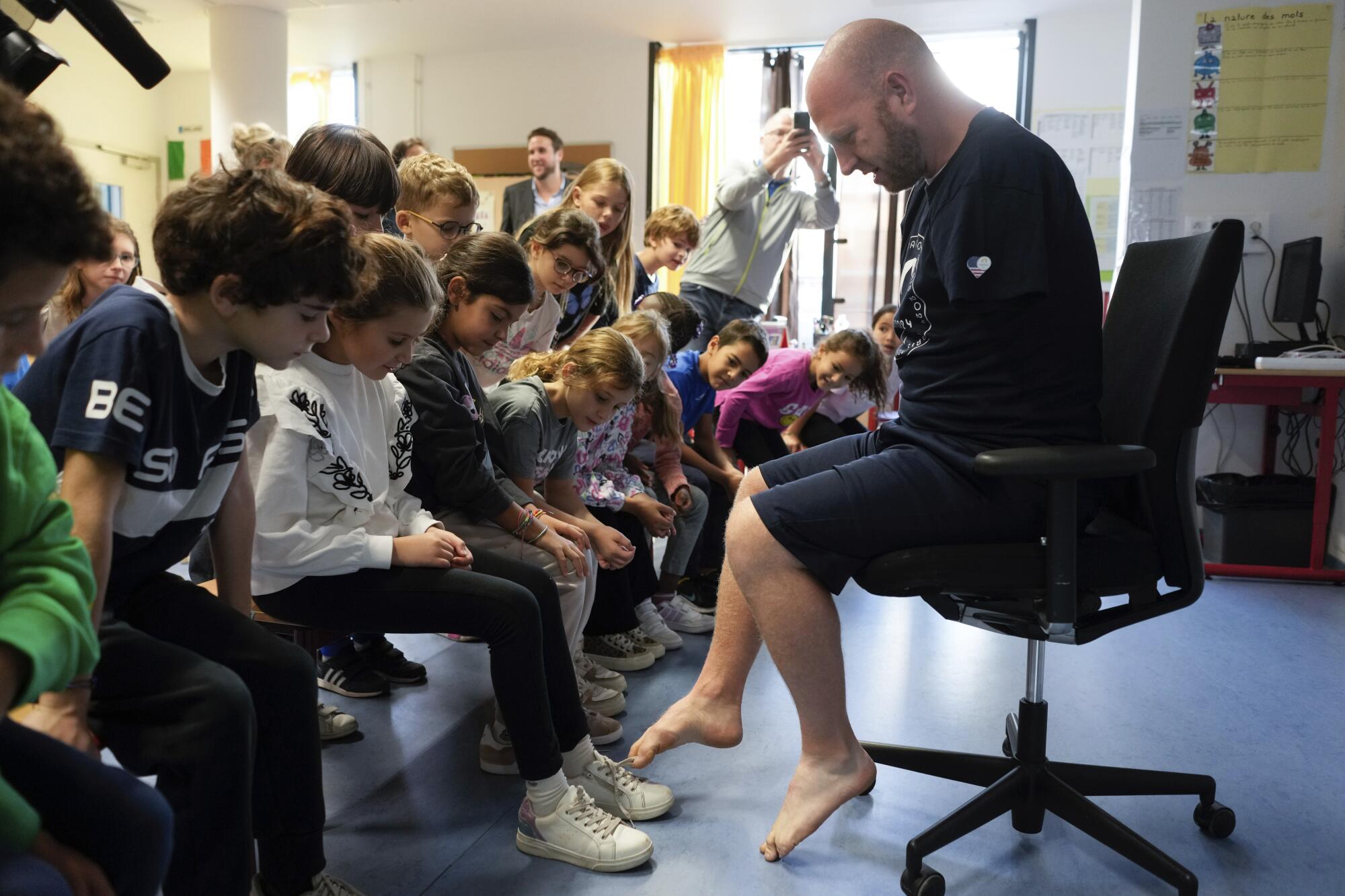
Their match began with one bull’s-eye after another, setting the tone for a tense duel. Stutzman suffered the first less-than-perfect shot, falling behind, but inched his way back into the lead by one point.
With a gold medal in the balance, each man had one last arrow. Ai scored a 10, putting the pressure on Stutzman to respond.
The venue fell silent as his final shot sailed toward the target, hitting with a thunk. Another 10. The crowd roared and Stutzman jumped from his chair, hollering and kicking his feet.
His unexpected tale had its golden ending, the bull’s-eye giving him the win with a record-setting score of 149 out of 150. That was one point better than anyone in Paralympic history, arms or not.
More to Read
Go beyond the scoreboard
Get the latest on L.A.'s teams in the daily Sports Report newsletter.
You may occasionally receive promotional content from the Los Angeles Times.








